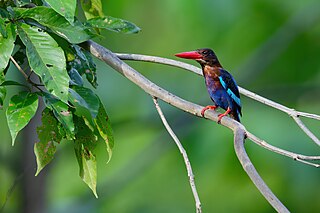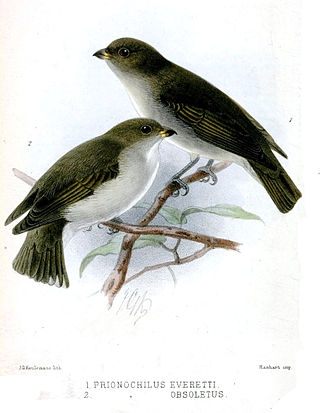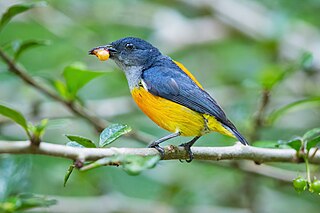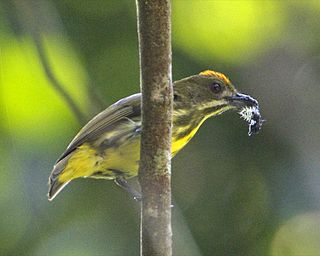
The flowerpeckers are a family, Dicaeidae, of passerine birds. The family comprises two genera, Dicaeum and Prionochilus, with 50 species in total. The family has sometimes been included in an enlarged sunbird family Nectariniidae. The berrypeckers of the family Melanocharitidae and the painted berrypeckers, Paramythiidae, were once lumped into this family as well. The family is distributed through tropical southern Asia and Australasia from India east to the Philippines and south to Australia. The family has a wide range occupying a wide range of environments from sea level to montane habitats. Some species, such as the mistletoebird of Australia, are recorded as being highly nomadic over parts of their range.

Dicaeum is a genus of birds in the flowerpecker family Dicaeidae, a group of passerines tropical southern Asia and Australasia from India east to the Philippines and south to Australia. The genus Dicaeum is closely related to the genus Prionochilus and forms a monophyletic group.

The thick-billed flowerpecker is a tiny bird in the flowerpecker group. They feed predominantly on fruits and are active birds that are mainly seen in the tops of trees in forests. It is a resident bird with a wide distribution across tropical southern Asia from India east to Indonesia and Timor with several populations recognized as subspecies some of which are sometimes treated as full species.

The olive-crowned flowerpecker is a small passerine bird in the flowerpecker family, Dicaeidae. It is found in far western New Guinea and on adjacent islands.

The mistletoebird, also known as the mistletoe flowerpecker, is a species of flowerpecker native to most of Australia and also to the eastern Maluku Islands of Indonesia in the Arafura Sea between Australia and New Guinea. The mistletoebird eats mainly the berries of the parasitic mistletoe and is a vector for the spread of the mistletoe's seeds through its digestive system.

The chestnut-breasted malkoha is a species of cuckoo in the family Cuculidae. Found in Southeast Asia from Myanmar through to eastern Java, the Philippines and Borneo, it is a large cuckoo measuring up to 49 cm (19 in) with grey and dark green upperparts and chestnut underparts, and a large curved pale upper mandible. The male and female are similar in plumage. Unlike many cuckoos, it builds its nest and raises its own young.

The Javan kingfisher, sometimes called the blue-bellied kingfisher or Java kingfisher, is a medium-sized kingfisher endemic to the Indonesian islands of Java and Bali.

The grey-sided flowerpecker is a species of bird in the family Dicaeidae. It is endemic to Indonesia. Its natural habitats are subtropical or tropical moist lowland forest and subtropical or tropical moist montane forest.

The scarlet-backed flowerpecker is a species of passerine bird in the flowerpecker family Dicaeidae. Sexually dimorphic, the male has navy blue upperparts with a bright red streak down its back from its crown to its tail coverts, while the female and juvenile are predominantly olive green. It is found in subtropical or tropical moist lowland forests and occasionally gardens in a number of countries throughout South and East Asia.

The brown-backed flowerpecker is a species of bird in the family Dicaeidae. The scientific name commemorates British colonial administrator and zoological collector Alfred Hart Everett.

The fire-breasted flowerpecker is a species of bird in the family Dicaeidae found in the Indian Subcontinent and Southeast Asia. Like other flowerpeckers, this tiny bird feeds on fruits and plays an important role in the dispersal of fruiting plants. Unlike many other species in the genus, this species has marked sexual dimorphism with the male having contrasting upper and lower parts with a distinctive bright orange breast patch. The female is dull coloured.

The black-sided flowerpecker, also known as the Bornean flowerpecker, is a species of bird in the family Dicaeidae. It is endemic to the island of Borneo, where it is found in the mountains, primarily above 1,000 m (3,300 ft) in elevation. The species is sexually dimorphic. The male has glossy blue-black upperparts, with a scarlet throat and breast, a dark grey upper belly, olive flanks, a white lower belly, and a buffy vent and undertail coverts. The female is olive-green above and greyish below, with buffy flanks and a whitish throat. It inhabits a range of forest habitats, including primary and secondary montane forest, kerangas forest, and scrub, and is also occasionally found in gardens. It feeds primarily on small fruits—particularly mistletoe berries—as well as seeds, nectar, and various invertebrates. It builds a nest of moss, camouflaged on the outside with lichens and lined with the pith of tree ferns. The International Union for Conservation of Nature rates it as a species of least concern. Though its numbers have not been quantified, the black-sided flowerpecker is said to be common throughout much of its range, and any declines are not thought to be precipitous. However, destruction of forest for palm plantations may impact it.

The whiskered flowerpecker is a species of bird in the family Dicaeidae. It is endemic to the island of Mindanao in the Philippines.

The orange-bellied flowerpecker is a species of bird in the family Dicaeidae. It is found in Bangladesh, Brunei, India, Indonesia, Malaysia, Myanmar, the Philippines, Singapore, and Thailand.

The ashy flowerpecker is a species of bird in the family Dicaeidae. It is endemic to Indonesia where it occurs on Seram, Ambon and nearby islands in the Banda Arc. Its natural habitats are subtropical or tropical moist lowland forest and subtropical or tropical moist montane forest.

The banded broadbill is a species of bird in the typical broadbill family Eurylaimidae found in Mainland Southeast Asia and the Greater Sunda Islands. It is sometimes split into two species, one including only the nominate subspecies, E. j. javanicus, and one including all the remaining subspecies. It inhabits a variety of forests, along with forest edge, rubber plantations and Falcataria falcata groves, mainly in lowland areas. A striking, large-bodied bird with a length of 21.5–23.0 cm (8.5–9.1 in), it is unlikely to be mistaken for another species. The broadbill is mostly purplish-red, with yellow-streaked black wings, a bright blue beak, a blackish face and greyish chin and upper breast. Females can be told apart from males by their lack of a black neckband, although these are indistinct in Bornean and Javan males. Despite its conspicuous appearance, the bird is usually hard to see due to its sluggishness and is usually only noticed when it vocalises.

The black-winged flycatcher-shrike is a species of bird in the flycatcher-shrike genus, Hemipus. It is usually placed in the Vangidae. It is found in the Malay Peninsula and the Greater Sunda Islands. Its natural habitats are lowland forests and sometimes swamps and mangroves. The International Union for Conservation of Nature (IUCN) has assessed it as being of least concern.

Prionochilus is one of two genera flowerpecker that make up the family Dicaeidae. The genus differs from the other flowerpecker genus, Dicaeum in having ten long primary feathers in the wing and in the character of its calls. A study comparing the calls of the two genera suggested that Prionochilus is basal to Dicaeum. The genus contains six species, in contrast to the 44 species in the genus Dicaeum. They have a more restricted distribution than Dicaeum, occurring in the Philippines, Borneo, Sumatra, Java and the Malay Peninsula. The name Prionochilus is derived from the Greek prion for saw, and kheilos for lip, referring to the minute serrations along the edge of the bill.

The plain flowerpecker is a bird in the family Dicaeidae. The species was described and given its binomial name by Robert Swinhoe in 1870. It is found in the central Himalayas, through western Indonesia to Taiwan.

The Wakatobi flowerpecker is a subspecies of the grey-sided flowerpecker that is endemic to the Wakatobi Islands of Indonesia. Some authorities consider it to be a separate species as Dicaeum kuehni.




















